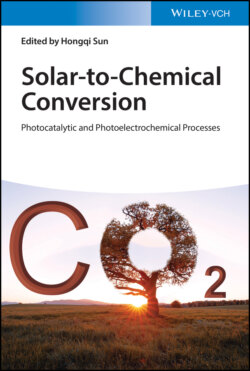Читать книгу Solar-to-Chemical Conversion - Группа авторов - Страница 17
2.4 Products of Artificial Photosynthesis 2.4.1 Hydrocarbons
ОглавлениеHydrocarbons as important products of photosynthesis provide almost all energy for living things that take advantage of chemical energy to maintain activities by oxidizing organics. In photosynthesis system, carbon dioxide is the mainly carbon source and transformed into hydrocarbons. Inspired by the nature, scientists attempt to hydrogenate CO2 to produce hydrocarbons as substitutes to traditional fossil fuels. In general, CO2 is one of the most thermodynamically stable carbon compounds. The photocatalytic reduction of carbon dioxide to hydrocarbons requires to consume large amounts of energy for dissociation of the C=O bond and formation of C—H bonds. Since the carbon atoms in CO2 are in the highest oxidation state, this process may occur only with the participation of reducing agents providing a certain amount of electrons. On the other hand, the corresponding protons participate oxidative reactions, such as water oxidation. Meanwhile, hydrogen in water can further give rise to CO2 reduction for formation of C–H. However, the reduction of CO2 by water to give organic compounds such as methanol or methane entails a reaction with a high positive Gibbs free energy change: CO2 + 2H2O → CH3OH + 1.5O2 (ΔG0 = 702.2 kJ mol−1); CO2 + 2H2O → CH4 + 2O2 (ΔG0 = 818.3 kJ mol−1). Therefore, to overcome these energy obstacles requires external energy source such as thermal energy, plasma, electrics, and solar irradiation. For example, in 1973, Inoue et al. reported that HCHO and CH3OH were produced by the reduction of CO2 with H2O in aqueous suspension systems under Xe lamp irradiation and electric field involving a variety of semiconductor photocatalysts such as TiO2, ZnO, and WO3 [19]. Meanwhile, trace formic acid and methane were detected over specific photocatalysts (SiC, GaP) by using special quantitative analysis methods. In contrast, in the absence of light source, no reduced products were detected in these systems, which strongly demonstrate that light excitation triggers the reduction reaction between CO2 with H2O in room temperature and normal pressure over the semiconductor photocatalysts. As shown in Figure 2.6, it is demonstrated that there are many reaction paths in reduction of CO2 under external field excitation, leading to the diversity of products so that selectivity is another important parameter to determine the performance of CO2 reduction photocatalysts. The possible reactions that can occur in the reduction of CO2 in the aqueous medium, under band‐gap illumination, ranging from one‐ to eight‐electron transfer, with thermodynamic potentials vs. NHE, are mentioned below:
(2.2)
(2.3)
(2.4)
(2.5)
(2.6)
(2.7)
Figure 2.6 A schematic illustration of the energy correlation between semiconductor catalysts and redox couples in water. CB and VB denote a conduction band and a valence band, respectively.
Source: Tu et al. [20].
To improve the selectivity of expected product, Anpo and coworkers reported a series of studies on photocatalytic reduction of CO2 with H2O for producing methanol and methane with a high selectivity by designing various nanostructured photocatalysts, such as Cu/TiO2 [21], TiO2/Y‐zeolites [22], Ti/FSM‐16 [23], and TiO2/glass [24] in Figure 2.7. The mechanism investigation results inferred that the local structure of TiO2 tested by X‐ray absorption near‐edge structure (XANES) on the support has significant influences in product selectivity. In this section, different products and reaction mechanism are respectively discussed in detail.
Figure 2.7 (a) Yields of the products produced during the photocatalytic reduction of CO2 with H2O and photoluminescence of various Ti/FSM‐16 photocatalysts. (b) Product distribution of CO2 photoreduction over 1‐TiO2, 2–10 wt% imp‐TiO2/Y‐zeolite, 3–1.0 wt% imp‐TiO2/Y‐zeolite, 4‐ex‐TiO2/Y‐zeolite, and 5‐Pt‐loaded ex‐TiO2/Y‐zeolite. (c) Schematic mechanisms of the photocatalytic CO2 reduction with H2O on TiO2.
Source: (a) Ikeuea et al. [23]; (b) Anpo et al. [22]; (c) From Anpo et al. [21]. © 1995 Elsevier.
